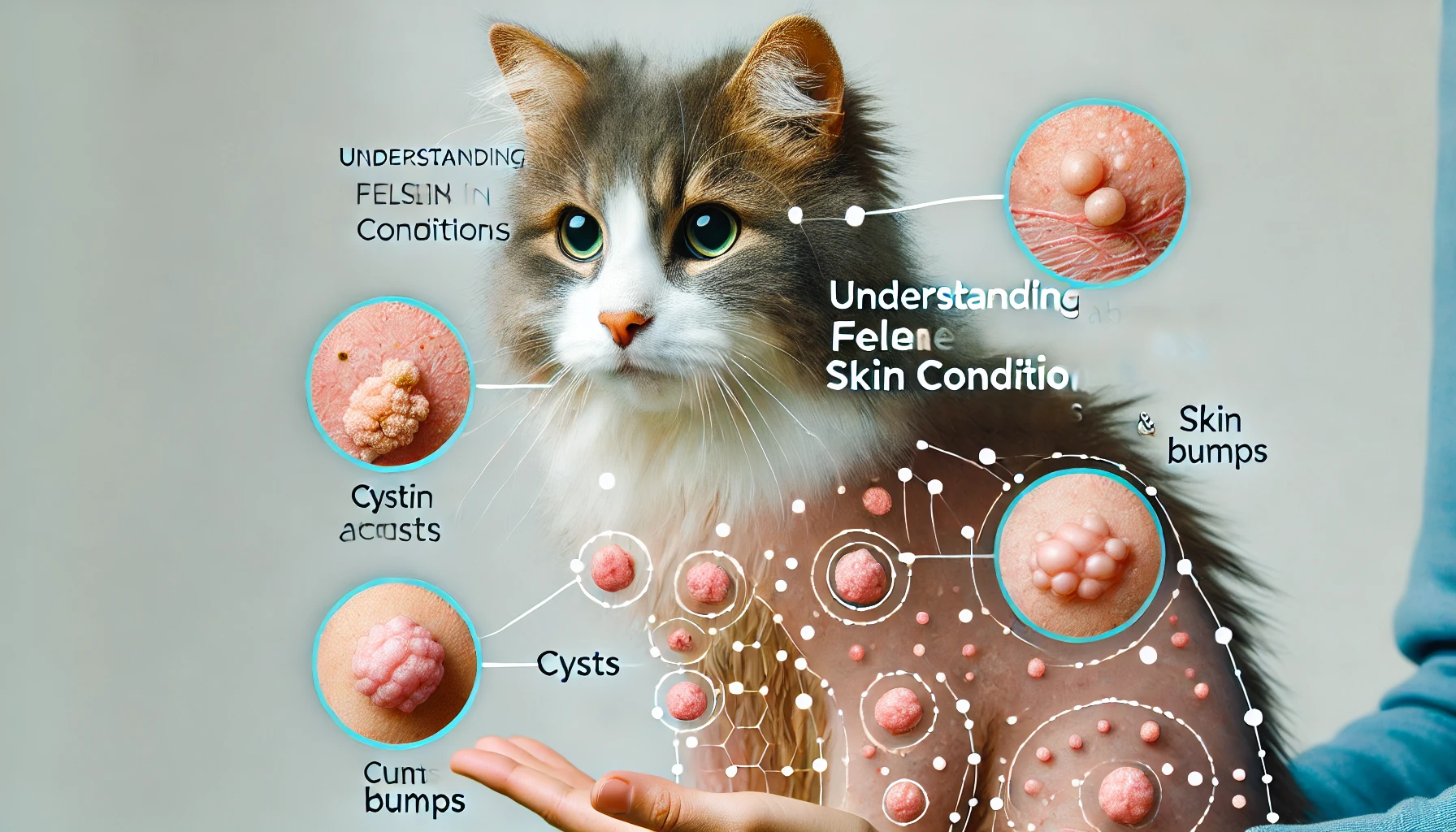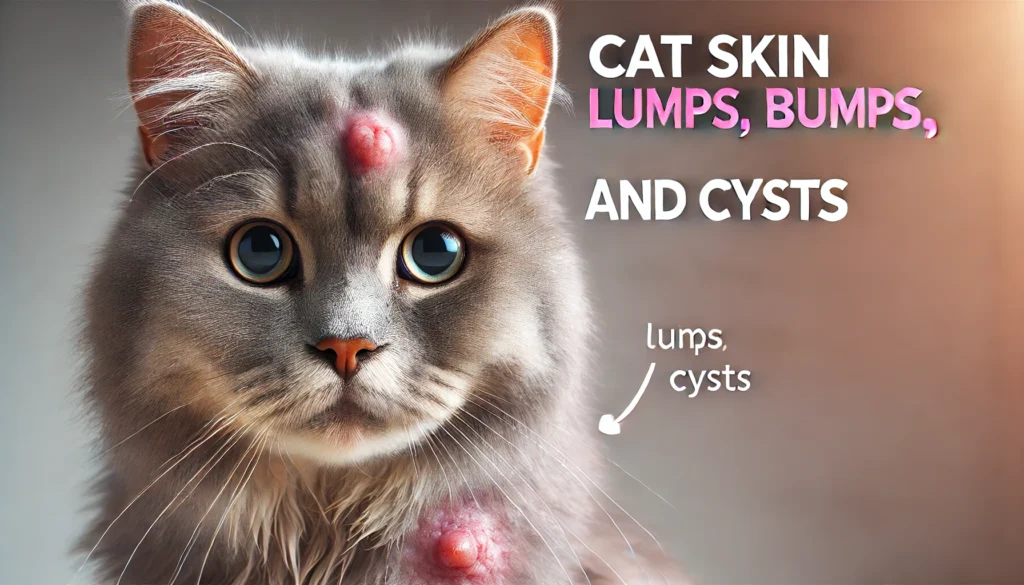Cat Skin Lumps, Bumps, and Cysts

Introduction
Skin anomalies such as Cat Skin Lumps, Bumps, and Cysts are common and can be signs of various underlying conditions, ranging from harmless to serious. This detailed guide is designed to help cat owners understand these conditions, recognize their signs, and learn about the treatment options available, ensuring they are well-prepared to manage their cat’s health.
Understanding Cat Skin Lumps, Bumps, and Cysts
Definition and Overview
Cat Skin Lumps, Bumps, and Cysts are terms often used interchangeably but they describe different issues under the skin. Lumps (like a lump on a cat’s neck or side) are generally larger and may be a sign of infection or tumors. Bumps (such as those on a cat’s head or paw) are usually smaller and less serious. Cysts are closed pockets of tissue that can be filled with fluid or pus, arising from various conditions, including blockages of ducts or reactions to foreign materials.
Types of Skin Abnormalities in Cats
- Lumps: These can vary from benign lipomas to more serious conditions like cancerous growths.
- Bumps: Commonly found as pimple-like formations caused by allergies or insect bites.
- Cysts: Including sebaceous cysts, which are typically filled with a cheese-like or oily material, and can appear anywhere on the body, such as the back, neck, or chin.
Common Causes of Cat Skin Lumps, Bumps, and Cysts
Allergic Reactions
Reactions to food, pollen, or flea bites can cause bumps and lumps, often accompanied by itching and discomfort.
Infections
Bacterial or fungal infections can lead to abscesses (a painful collection of pus) or other noticeable lumps on the skin, like those seen on a cat’s lip or under its chin.
Parasitic Infestations
Fleas and ticks can cause small bumps that may develop into larger lumps if a secondary infection occurs.
Sebaceous and Other Cysts
Cysts may develop due to blocked glands, such as sebaceous cysts, or around foreign bodies. These are often seen as growths on the skin or under it, like those on a cat’s paw pads or neck.
Benign Tumors
Lipomas (fatty tumors) and warts can appear as soft lumps and are usually not painful. These might be found on the belly or ribs.
Cancerous Growths
Malignant tumors such as squamous cell carcinoma or mast cell tumors can manifest as lumps or growths on various parts of the body and require immediate veterinary attention.
do you know
Cat Love Bites: Explains the nature of cat love bites as a common yet often misunderstood form of feline communication and affection. The section will set the stage for deeper exploration into why and how cats express their feelings through nibbling.
Diagnosing Cat Skin Lumps, Bumps, and Cysts
Physical Examination
This includes evaluating the lump’s location, size, consistency, and whether it’s painful, which helps in preliminary assessments.
Diagnostic Tests
Fine needle aspiration, biopsies, and imaging like X-rays help determine the nature of the lump. This is crucial for lumps that develop rapidly, like those that appear overnight.
Sample Analysis
Analyzing the content of cysts or lumps, especially those suspected of being abscesses or sebaceous cysts, provides definitive information on the underlying cause.

Treatment Options
Medication
Antibiotics may be used for infected lumps, and antihistamines or corticosteroids for allergic reactions that cause skin bumps.
Surgical Removal
This is recommended for cysts that recur or cause discomfort, as well as for biopsy or treatment of potentially cancerous lumps.
Supportive Care
Includes keeping the area clean, applying warm compresses to reduce discomfort, and monitoring for changes in the lump’s characteristics.
Home Care and Management
Regular Monitoring
Keep an eye on the size and condition of the Cat Skin Lumps, Bumps, and Cysts, and watch for signs of infection or sudden growth, which should be reported to a vet.
Diet and Hygiene
Feeding a balanced diet and regular grooming can help prevent skin issues and keep minor bumps and lumps under control.
Stress Reduction
Reducing stress through environmental enrichment can help improve your cat’s overall skin health and reduce the occurrence of stress-related skin issues.
When to See a Veterinarian
It’s crucial to consult with a veterinarian if the lump changes rapidly or if it bothers your cat. Early detection and treatment are key to managing more serious conditions effectively.
Conclusion
Understanding the signs and possible causes of Cat Skin Lumps, Bumps, and Cysts is essential for early detection and effective treatment. With the right knowledge and timely veterinary care, most skin conditions in cats can be managed successfully, ensuring your cat remains healthy and comfortable.
What are the Cat Skin Lumps, Bumps, and Cysts?
Lumps and bumps can be caused by infections, allergies, cysts, or tumors. A vet should examine persistent or changing bumps.
What is the treatment for cat cyst?
Treatment typically involves draining or surgically removing the cyst. Some cysts are treated with medication if infection is present.
How do you treat lipomas in cats?
Lipomas in cats are usually left untreated unless they impair movement or grow excessively, in which case surgical removal may be recommended.
Why does my cat have lumps in his fur?
Lumps in your cat’s fur could be due to parasitic infections, cysts, lipomas, or other skin conditions that require veterinary evaluation.
Will a cat cyst heal on its own?
Some cysts can resolve on their own if they drain naturally and the underlying cause is addressed, but others might require veterinary intervention.
Are cysts harmful to cats?
Most cysts are benign and not harmful unless they become infected or grow large enough to cause discomfort or mobility issues.
What foods heal lipomas?
There’s no conclusive evidence that specific foods can heal lipomas. Maintaining a healthy weight and balanced diet is generally recommended.
Can lipoma reduce by itself?
Lipomas typically do not reduce on their own. They usually stay the same size or grow slowly and do not regress without intervention.
